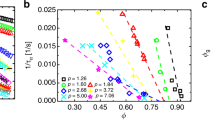Abstract:
We study self-diffusion within a simple hopping model for glassy materials. (The model is Bouchaud's model of glasses (J.-P. Bouchaud, J. Phys. I France 2, 1705 (1992)), as extended to describe rheological properties (P. Sollich, F. Lequeux, P. Hébraud, M.E. Cates, Phys. Rev. Lett. 78, 2020 (1997)).) We investigate the breakdown, near the glass transition, of the (generalized) Stokes-Einstein relation between self-diffusion of a tracer particle and the (frequency-dependent) viscosity of the system as a whole. This stems from the presence of a broad distribution of relaxation times of which different moments control diffusion and rheology. We also investigate the effect of flow (oscillatory shear) on self-diffusion and show that this causes a finite diffusivity in the temperature regime below the glass transition (where this was previously zero). At higher temperatures the diffusivity is enhanced by a power law frequency dependence that also characterises the rheological response. The relevance of these findings to soft glassy materials (foams, emulsions etc.) as well as to conventional glass-forming liquids is discussed.
Similar content being viewed by others
Author information
Authors and Affiliations
Additional information
Received 31 August 1998 and Received in final form 25 January 1999
Rights and permissions
About this article
Cite this article
Evans, R., Cates, M. & Sollich, P. Diffusion and rheology in a model of glassy materials. Eur. Phys. J. B 10, 705–718 (1999). https://doi.org/10.1007/s100510050902
Issue Date:
DOI: https://doi.org/10.1007/s100510050902




